ToF meeting, Long Beach, CA
Filed in: 2010
“It is a truth, universally acknowledged, that a male mouse in possession of darcin must be in want of a mate”*
As proteomics moves beyond the discovery phase, there is increasing interest in formal quantification of proteins in complex biological systems. Attractive as label-free methods are, they struggle at low column loadings, and in situations where many of the peptides that are captured are common to multiple isoforms. In this presentation, I will discuss quantitative approaches as applied to the major urinary proteins (MUPs) in mice. Unlike many other species, mice have an obligate proteinuria, comprising proteins specifically secreted into urine to convey a subtle, complex and information-rich semiochemical message. The MUPs are encoded by a heavily duplicated region of chromosome IV and are highly polymorphic - differences between individual proteins can be as little as one or two amino acids in the entire 19kDa sequence. To quantify these isoforms, we have used a combination of ESI-MS of the intact proteins and a variant of stable isotope labeled internal standardization, based on QconCAT technology, in which we construct artificial genes that are designed such that when they are proteolysed they create an equimolar mix of peptide level standards for surrogate protein quantification. The similarity of the MUP sequences means that there is no single unique QconCAT solution, and a combinatorial approach is required.
In my talk I will briefly introduce the QconCAT approach and show how the method can be applied to polymorphic variants of proteins, and be used to validate other methods of quantification.
Roberts SA, Simpson, Armstrong, Davidson, Robertson, McLean, Beynon & Hurst JL (2010) Darcin: a male pheromone that stimulates female memory and sexual attraction to an individual male’s odour. BMC Biology 8:75.
Mudge JM, Armstrong SD, McLaren K, Beynon RJ, Hurst JL, Nicholson C, Robertson DH, Wilming LG, Harrow JL. (2008) Dynamic instability of the major urinary protein gene family revealed by genomic and phenotypic comparisons between C57 and 129 strain mice. Genome Biol. 9, R91.
Robertson D H, Wong SC, Beynon RJ, Hurst JL, Gaskell SJ. (2008) Observation of heterogeneous gene products by FT-ICR MS. J. Am. Soc. Mass Spectrom. 19, 103-110.
Sherborne AL, Thom MD, Paterson S, Jury F, Ollier WE, Stockley P, Beynon RJ, Hurst JL. (2007) The genetic basis of inbreeding avoidance in house mice. Curr. Biol. 17, 2061-2066.
Cheetham SA, Thom MD, Jury F, Ollier WE, Beynon RJ, Hurst JL. (2007) The genetic basis of individual-recognition signals in the mouse. Curr. Biol. 17, 1771-1777.
As proteomics moves beyond the discovery phase, there is increasing interest in formal quantification of proteins in complex biological systems. Attractive as label-free methods are, they struggle at low column loadings, and in situations where many of the peptides that are captured are common to multiple isoforms. In this presentation, I will discuss quantitative approaches as applied to the major urinary proteins (MUPs) in mice. Unlike many other species, mice have an obligate proteinuria, comprising proteins specifically secreted into urine to convey a subtle, complex and information-rich semiochemical message. The MUPs are encoded by a heavily duplicated region of chromosome IV and are highly polymorphic - differences between individual proteins can be as little as one or two amino acids in the entire 19kDa sequence. To quantify these isoforms, we have used a combination of ESI-MS of the intact proteins and a variant of stable isotope labeled internal standardization, based on QconCAT technology, in which we construct artificial genes that are designed such that when they are proteolysed they create an equimolar mix of peptide level standards for surrogate protein quantification. The similarity of the MUP sequences means that there is no single unique QconCAT solution, and a combinatorial approach is required.
In my talk I will briefly introduce the QconCAT approach and show how the method can be applied to polymorphic variants of proteins, and be used to validate other methods of quantification.
Roberts SA, Simpson, Armstrong, Davidson, Robertson, McLean, Beynon & Hurst JL (2010) Darcin: a male pheromone that stimulates female memory and sexual attraction to an individual male’s odour. BMC Biology 8:75.
Mudge JM, Armstrong SD, McLaren K, Beynon RJ, Hurst JL, Nicholson C, Robertson DH, Wilming LG, Harrow JL. (2008) Dynamic instability of the major urinary protein gene family revealed by genomic and phenotypic comparisons between C57 and 129 strain mice. Genome Biol. 9, R91.
Robertson D H, Wong SC, Beynon RJ, Hurst JL, Gaskell SJ. (2008) Observation of heterogeneous gene products by FT-ICR MS. J. Am. Soc. Mass Spectrom. 19, 103-110.
Sherborne AL, Thom MD, Paterson S, Jury F, Ollier WE, Stockley P, Beynon RJ, Hurst JL. (2007) The genetic basis of inbreeding avoidance in house mice. Curr. Biol. 17, 2061-2066.
Cheetham SA, Thom MD, Jury F, Ollier WE, Beynon RJ, Hurst JL. (2007) The genetic basis of individual-recognition signals in the mouse. Curr. Biol. 17, 1771-1777.
